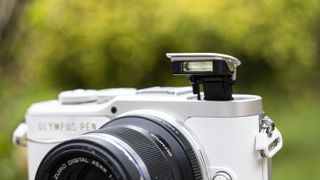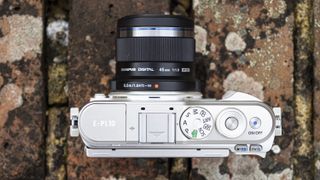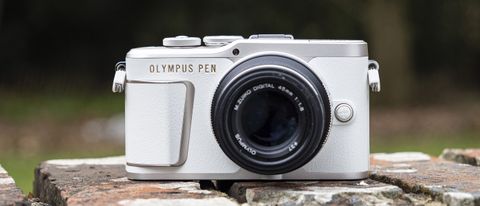TechRadar Verdict
There is plenty to like about the E-PL10; it looks great, has an array of creative and beginner friendly shooting modes, the JPEG color rendition is lovely and natural, plus 4K videos are supported by powerful image stabilization. On the flip side, the camera does have its limitations. We did miss a viewfinder from time to time, image quality in low contrast light suffers and you’ll need a little know-how to get the best from AF. Still, the E-PL10 remains a fun little camera, even if the E-PL9 offers better value.
Pros
- +
Lots of beginner-friendly modes
- +
In-body image stabilization
- +
In-camera Raw editing
- +
Lovely JPEG color rendition
- +
Silent shutter mode
Cons
- -
No viewfinder option
- -
Sensor a little dated
- -
Contrast AF can be hit-and-miss
Why you can trust TechRadar
Olympus has two retro-style line-ups in its mirrorless camera range; PEN and OM-D. A key difference between the two line-ups is that PEN cameras have a flat profile without a built-in viewfinder. The PEN E-PL10 is the latest iteration in this entry-level mirrorless camera range.
There is plenty in the E-PL10 to entice those new to photography – lovely images, an unparalleled array of fun shooting modes, an intuitive flip touchscreen, and powerful image stabilization. Yes, this retro-style camera is a very capable shooter that makes stepping up from using a smartphone easier, plus it throws in a few manual controls too.
We’ll say straight off the bat that you’ll need a magnifying glass to tell the differences between the E-PL10 and the E-PL9, two years its predecessor. There is an overall feeling, not exclusive to Olympus, that these beginner mirrorless cameras are not high on the priority list.
It’s no bad thing per se, because we loved the Olympus E-PL9, but there is less to get excited about here. So does the E-PL10 do enough to succeed in 2020?
Now the E-PL10 has been around for a little while, prices have gone down. As such, it's now one of the best cheap cameras you can buy.
Olympus PEN E-PL10 release date and price
You can buy the Olympus PEN E-PL10 right now, either body-only or in a Pancake Zoom kit with the M.Zuiko Digital ED 14‑42mm F3.5‑5.6 EZ pancake lens.
The body-only price is $600 / £550 (it's not available body-only in Australia), though we've already seen some discounts on that price.
If you don't have any existing lenses, then the Pancake Zoom kit is the better bet and costs $700 / £650 / AU$1199. If that's a little outside your budget, then it's well worth considering the Olympus E-PL9 too, given that model only really lacks the new fine-tuning of Olympus' art filters.



Build and handling
- Stylish polycarbonate build
- No viewfinder
- 3in, 1.04-million-dot tilt-touch screen with underside selfie mode
Straight out of the box, the E-PL10 will put a smile on your face because it’s a dinky and attractive camera. Looks alone could seal the deal for some.
We had the white version with a gold, embossed Olympus logo, but it’s also available in black or tan. The body is covered in a tactile faux leather and sandwiched between top and bottom metal-effect plates.
A thumb grip and curved front hand grip provide some extra purchase, although you wouldn’t want to use particularly heavy lenses – those are more suited to cameras in the OM-D range, like the Olympus OM-D E-M5 Mark III.
Being an entry-level camera, the E-PL10 has a plastic build, which is more obvious on the top and bottom plates. However, all of the controls feel solid enough, the faux-leather is delicious and the top dials are particularly pleasant to rotate.



The buttons on the rear are a tad on the small side – Olympus has opted for style over function by surrounding those buttons with a trim rather than maximizing the space.
By default, the 2x digital teleconverter is set to the Fn button on the top right. In practice, it’s highly likely you’ll activate the teleconverter by mistake, so unless you want to use that feature a lot, we recommend changing the function.
A tilt-touchscreen dominates the rear. It will flip 180-degrees to the underside of the camera for viewing from the front, appeasing the occasional selfie. Yet without a socket for an external microphone, this is no blogger's camera.
Sensor: 16.1MP Four Thirds
Image processor: TruePic VIII
Stabilization: Sensor shift up to 3.5EV (or 3.5 stops)
Autofocus: 121-point Contrast Detection
ISO range: 200 to 6,400 (expanded to ISO 100-25,600)
Video: 4K up to 30fps and Full HD up to 30fps
Max burst: 8.6fps
All in all, the touch function works smoothly, which is really important on an entry-level camera. For example, those used to a camera phone will feel at home here. You get touch shutter, touch AF, plus swipe control in image playback and magnification for closer inspection.
If you select the Advanced Photo mode, it’s possible to select which mode you want by touch. In addition, the brightness of Art Filters can now be adjusted through the exposure compensation slider.
In video mode, the touchscreen can be used to zoom the lens in and out, with a slow and a quick setting – that’s a nice touch. However, you cannot navigate the main menu by touch.
Unsurprisingly, at times it’s hard to see the screen in bright light and glare. And there's sadly no way around that, without an option to attach an electronic viewfinder. For framing shots, you're entirely reliant on the screen.

A pop-up flash is included along with a hotshoe to attach external flash guns. The amount of manual control available for flash setups goes above and beyond the typical target audience.
Battery life is solid, at 350 shots from a full charge. Olympus deserves kudos for including a battery charger unit too, which is never a given at this level. However, it’s not possible to charge the camera on-the-go via a power bank. Additional batteries, should you need one, are quite expensive too. Still, packing a single battery only caught us out on one occasion.
Ultimately, how a camera looks and its ease of use are two key reasons to keep coming back to it again and again, especially for a beginner. And the E-PL10 scores well on both counts.
Features
- In-body image stabilization (IBIS)
- Art Filters and Advanced Photo mode
- 4K video at 30fps, 102Mbps
Olympus has settled on a tried-and-tested 16.1-million-pixel sensor on the E-PL10. By current standards, this resolution is modest. However, image quality isn’t all about how large you can print or view the images at 100% size (without loss of quality due to interpolation). There is plenty to like about the photos that the E-PL10 creates – more on that later.
Video specification is pretty much identical to the E-PL9, which impressed on its launch two years ago. There is 4K video at 30fps. Crucially, again, the E-PL10 offers in-body image stabilization (IBIS), for both video and photos.
Image stabilization is Olympus’ base offering, which means it's up to 3.5EV (or 3.5 stops). Yet in use, it’s possible to get really smooth handheld videos. There are not too many other cameras at this level with such a feature and Olympus has long offered class-leading stabilization.

As usual, there are a host of art filters, included in the menu with the regular color modes. Add them all up, including the variants of filters like Pin Hole and Vintage, and there’s a total of 38. With Raw image in-camera editing, any of these filters can be applied post capture. A lot can be done to an image in-camera, which isn't always the case.
Pictures can also be captured, shared and edited wirelessly using the Olympus Image Share app. Using a Apple iPhone, we enjoyed a smooth experience.
We’ve also had fun using the Advanced Photo modes – in general, they are user-friendly for any skill level. For example, multiple exposure displays the first of two shots, so you can line up the next one precisely for the composite.




'Live Time' is for long exposure shots and displays the brightness of the image during exposure, so that you know the right moment to stop the shot. A downside is that you are locked into the maximum aperture of the lens.
Yes, Advanced Photo modes do come with some confusing restrictions. Panorama only shoots in the vivid color mode (plus it fails quite a lot). Try another mode and you may get to choose the color style.
Ultimately, Advanced Photo is a gateway into creative shooting techniques. Once you have got the taste, all of these effects can be achieved manually with a little knowhow and you'll obtain control over elements such as color mode and aperture.
However, even those that already know how to do such styles can enjoy how the E-PL10 takes the hard work out of getting these creative shots. And this is the beauty of a camera like the E-PL10 – it’s fun for users of all abilities.



Image quality
- Solid color rendition
- Limited dynamic range
- 4k videos aided by image stabilization
The E-PL10 has a 16.1-million-pixel resolution, which is lower than most. At 300ppi print resolution, it makes for a 40x30cm print. As an entry-level camera and all-round family snapper, we feel the pixel count is still sufficient today.
With a good range of lenses available, including some that are a sensible price- and size-match such as the 45mm f/1.8 and 12mm f/2, the E-PL10 can push your photography further.
In sunny conditions, the E-PL10 can make sharp images full of contrast and tonal range, backed up by a lovely color rendition. JPEG photos – that’s those straight out of the camera – especially using the ’natural’ color profile, look great. Art Filters provide fun alternative styles, too.




For a camera that might be used a lot for general family shots, poor low light performance would be more of a turn-off than low-resolution. The native sensitivity range of ISO 200-6400 is modest, suggesting that E-PL10 images will struggle more than larger-format cameras in low contrast light.
Detail in JPEG images at a sensitivity setting above ISO 1600 is quite smudged. If you shoot in Raw format instead, the same detail improves. Alternatively, we would actually suggest delving into the camera menu and turning noise reduction off, if that is possible in the selected shooting mode.
We must mention the impact of in-body image stabilization (IBIS) on image quality. Regarding video, we have been really pleased how 4K handheld videos have come out – really smooth movement and crisp detail. As for photos, the 3.5 stops of stabilization enables extra light intake, while keeping stationary subjects sharp in handheld pictures.



Verdict
The Olympus PEN E-PL10 is a competent and stylish entry-level camera. It’s a camera that you want to hold, and one that injects fun into the experience of making pictures. Users of any ability can enjoy the choice of auto shooting modes or manual control.
The LCD tilt-touchscreen functions well, especially for the auto shooting modes. It’s a shame there is no option for a viewfinder because the screen can be hard to see in bright light. Handling-wise though, the show stopper is in-body image stabilization. It’s possible to get smooth videos and crisp photos.
The 16.1MP resolution Four Thirds sensor may appear underwhelming – there is scope for better image quality across a wider range of scenarios from rivals like the Fujifilm X-A7 and Sony A6100, for example – but you do get JPEGs with a lovely color rendition and the option to edit Raw images in-camera.
On the other hand, there is little reason to consider the E-PL10 over its predecessor, which two years old and a lot cheaper. Furthermore, the similarly priced Olympus OM-D E-M10 Mark III is a more enticing prospect, with a built-in viewfinder and better handling.
Even without much change in two years, the E-PL10 does still hold its own today. It’s price tag right now is a tad high, but with saver deals that we have already seen, this could be a good option for starting your photography journey.
The competition

Panasonic Lumix GX880
Being such a minor upgrade, the Olympus PEN E-PL10 faces competition from its peers - the E-PL9 predecessor is cheaper, while the OM-D E-M10 Mark III features a built-in viewfinder and better handling. Elsewhere is Panasonic’s entry-level mirrorless camera, the Lumix GX880 (aka GF10). In its favour, the E-PL10 has 3-axis sensor-shift image stabilisation (you’ll need a lens with stabilisation for the GX880), a quicker continuous drive mode, plus it’s battery life is approximately 30% better. The Panasonic camera is lighter and cheaper. On paper, the Olympus camera edges it.
- These are the best cheap cameras you can buy right now

Tim is the Cameras editor at TechRadar. He has enjoyed more than 15 years in the photo video industry with most of those in the world of tech journalism. During his time as Deputy Technical Editor with Amateur Photographer, as a freelancer and consequently editor at Tech Radar, Tim has developed a deeply technical knowledge and practical experience with cameras, educating others through news, reviews and features. He’s also worked in video production for Studio 44 with clients including Canon, and volunteers his spare time to consult a non-profit, diverse stories team based in Nairobi. Tim is curious, a keen creative, avid footballer and runner, and moderate flat white drinker who has lived in Kenya and believes we have much to enjoy and learn from each other.
